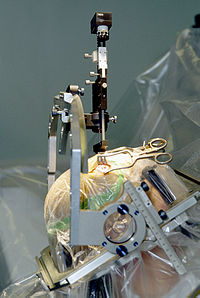
Photo from wikipedia
OBJECTIVE Functional endonasal sinus surgery (FESS) is widely practiced and is considered a generally safe procedure. Skull base injuries occur in Click to show full abstract
OBJECTIVE Functional endonasal sinus surgery (FESS) is widely practiced and is considered a generally safe procedure. Skull base injuries occur in <1% of procedures and are typically associated with cerebrospinal fluid leaks. Rarely, skull base injuries might result in cerebral lesions. Here we present a series of 4 patients with iatrogenic perforating injuries of the anterior skull base and cerebral lesions after routine FESS. METHODS Four patients with iatrogenic perforating cerebral lesions after routine FESS, performed at other institutions, were referred to a tertiary neurosurgery department. Within a 10-year period these procedures were performed in 3 patients as endoscopic FESS and as a microscopic FESS in 1 patient. RESULTS There were 3 men and 1 woman. Mean age at the time of surgery was 50 years. In 3 instances (in which an endoscope was used), the ear, nose, and throat physician had noted perforation of the skull base during surgery, but it went unnoticed in 1 patient operated with the microscope. Frontal lobe hematoma occurred in all patients, and in 3 of them cerebral infarction developed secondary to injury of branches of the anterior cerebral artery. Three patients developed acute hydrocephalus. Two had rapid global brain swelling and they succumbed within days. The other 2 patients survived without apparent neurological deficits. CONCLUSIONS Cerebral lesions during FESS still occur in contemporary surgery and they are possibly underreported. Even with prompt conservative and surgical measures, these lesions may result in catastrophic outcome. Associated vascular injuries have a worse prognosis. The only risk factor associated with lethal outcome in our series was younger age.
Journal Title: World neurosurgery
Year Published: 2017
Link to full text (if available)
Share on Social Media: Sign Up to like & get
recommendations!